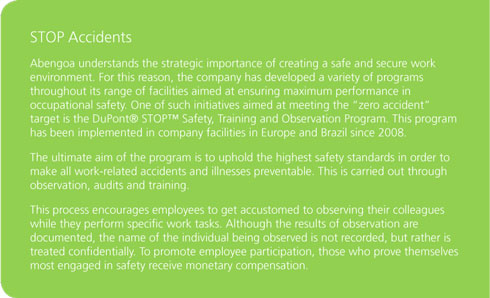 Abengoa
Abengoa
Annual Report 2012
- Corporate Social Responsibility
- People
- Our team
- Occupational health and safety
Occupational risk prevention is a strategic element at Abengoa and ORP management is integrated throughout the organization and the entire network of group companies and work facilities.
With the aim of guaranteeing occupational health and safety of workers, the company implements occupational risk prevention systems that are effective, efficient and certifiable and based on four essential underpinnings:
- Principles of Abengoa’s occupational risk prevention policy.
- Applicable law in each country of company operation.
- Contractual requirements of the company’s customers in this area.
- Requirements of the OHSAS 18001 Standard, an international norm pertaining to occupational health and safety management systems.
All group companies hold Prevention Committee meetings in compliance with OHSAS5 in accordance with the specifications of Abengoa’s Common Management Systems. As an instrument for ongoing improvement of the occupational risk prevention system, workers are provided with tools enabling them to generate Troubleshooting Reports (TSR) and Improvement Actions (IA), which optimize steps to be taken in the event of a work-related accident.
The company has joint prevention-related committees in place with participation from executive and ORP individuals in charge of analyzing work-related accidents, changing patterns, targets and planning (training, periodic controls, health monitoring, etc.).
Proof of Abengoa’s awareness in the realm of Occupational Risk Prevention is found in the rise in the number of hours dedicated to training in this area; instruction hours increased by 7.3 % from 2011 to 2012.
In 2012, Abengoa held its 11th Occupational Risk Prevention (ORP) Session, with 128 senior managers in attendance. The presentations, delivered by the different people in charge of occupational risk prevention across the range of business divisions, focused fundamentally on methodologies for managing risks associated with the organizational model and on ORP as a source of competitive advantage.
Abengoa also carried out global analysis of the psychosocial risks linked to work activity in 2012. To this end, questions related to this area were added to the questionnaire on work climate, using CoPsoQ Istas 21 methodology 6 (ISTAS 21Questionnaire for Evaluating Psychosocial Risks in the Workplace as the basis, as well as assorted assessment criteria.
Work-related accidents and absenteeism in figures
The following tables show the accident rates for 2012 and 2011. Abengoa’s ongoing efforts to prevent accidents are reflected in the drop in the number of accidents entailing leave from work, leading to a reduction in the accident frequency and severity rates.

Regrettably, four Abengoa employees were killed 2012 on the road while travelling to and from work. The company remains fully committed to driving down its accident rate.

Thanks to the reduction in the number of accidents and in the severity of these when they do occur, the number of working hours lost for this reason has also fallen.



Note 5: The percentage of certified companies can be found in the chapter titled Customers.
Note 6: Adaptation for the country of Spain of the Copenhagen Psychosocial Questionnaire (CoPsoQ).


© 2012 Abengoa. All rights reserved
